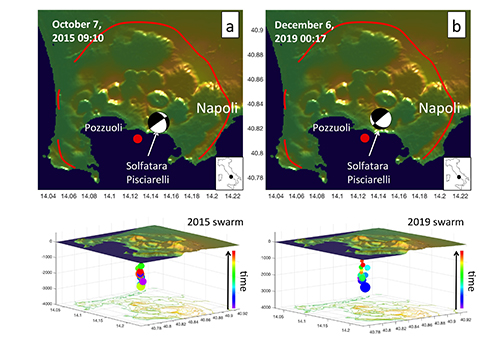
Continua senza sosta il monitoraggio multidisciplinare dei Campi Flegrei. Un nuovo studio dell’INGV in collaborazione con l’Università di Bari e l’Université Savoie Mont Blanc, illustra la possibile correlazione tra risalita di gas e due sciami sismici avvenuti nel 2015 e 2019.
Comprendere sempre meglio i processi in atto ai Campi Flegrei. E’ questo l’obiettivo dello studio multidisciplinare condotto dall’Istituto Nazionale di Geofisica e Vulcanologia (INGV) dal titolo “Tracking Episodes of Seismicity and Gas Transport in Campi Flegrei Caldera Through Seismic, Geophysical, and Geochemical Measurements”, appena pubblicato sulla rivista Seismological Research Letters.
“Lo studio”, spiega Flora Giudicepietro, ricercatrice dell’Osservatorio Vesuviano dell’INGV, “si è basato su analisi multiparametriche, cioè sull’elaborazione di dati provenienti da più discipline. In particolare, sono stati correlati i dati sismici (parametri dei terremoti e del tremore fumarolico), i dati geodetici (sollevamento del suolo) e i dati geochimici (emissione di gas nella zona di Pisciarelli): tre categorie diverse di informazioni ma tutte necessarie per definire lo stato di attività di un vulcano e per comprenderne l’evoluzione.
I risultati della ricerca hanno permesso di identificare due episodi di sismicità, avvenuti il 7 ottobre 2015 e il 6 dicembre 2019, in cui i dati registrati possono essere interpretati come dovuti ad apporti di gas nel sistema idrotermale dei Campi Flegrei”.
“Attraverso questa analisi multidisciplinare”, prosegue Flora Giudicepietro, “è stato possibile evidenziare che nelle due date in esame si sono verificati degli sciami sismici caratterizzati da eventi con magnitudo maggiore rispetto a quella generalmente molto piccola dei terremoti flegrei, che sono stati entrambi preceduti da un incremento della velocità di sollevamento del suolo. Inoltre, l’ampiezza del tremore generato dalla principale fumarola dell’area di Pisciarelli (in prossimità della Solfatara e vicino al confine comunale tra Pozzuoli e Napoli), ha evidenziato un incremento dell’attività idrotermale durante e dopo gli sciami”.
Per determinare con precisione l’ampiezza del tremore fumarolico è stato utilizzato il segnale di una stazione sismica posizionata a soli 8 metri di distanza dalla fumarola di Pisciarelli.
“Questa stazione”, aggiunge la ricercatrice, “ha permesso di raccogliere dati che danno un’indicazione dell’attività della fumarola in oggetto, che ben si correla anche con quelle della Solfatara. La ricerca continua, per comprendere sempre meglio i processi in atto nei Campi Flegrei”, conclude Flora Giudicepietro.
La ricerca pubblicata ha una valenza essenzialmente scientifica, priva al momento di immediate implicazioni in merito agli aspetti di protezione civile.
----
INGV, a new study highlights possible relationships between seismic episodes that occurred in 2015 and 2019 and the ascent of gas in Campi Flegrei
The multidisciplinary monitoring of the Campi Flegrei continues unabated. A new study by INGV in collaboration with the University of Bari and the Université Savoie Mont Blanc, illustrates the possible correlation between gas rising and two seismic swarms that occurred in 2015 and 2019.
To better understand the processes taking place in the Campi Flegrei. This is the goal of the multidisciplinary study conducted by the Istituto Nazionale di Geofisica e Vulcanologia (INGV) entitled "Tracking Episodes of Seismicity and Gas Transport in Campi Flegrei Caldera Through Seismic, Geophysical, and Geochemical Measurements", just published in the journal Seismological Research Letters.
"The study", explains Flora Giudicepietro, researcher at the Osservatorio Vesuviano of INGV, "was based on multiparametric analyzes, that is, on the processing of data from multiple disciplines. In particular, seismic data (parameters of earthquakes and fumarolic tremor), geodetic data (ground uplift) and geochemical data (gas emission in the Pisciarelli area) were correlated: three different categories of observations but all necessary to define the state of activity of a volcano and to understand its evolution.
The results of the research made it possible to identify two seismic episodes, which took place on 7 October 2015 and 6 December 2019, in which the recorded data can be interpreted as due to gas inputs in the hydrothermal system of the Campi Flegrei".
"Through this multidisciplinary analysis", continues Flora Giudicepietro, "it was possible to highlight that in the two dates under examination there were seismic swarms characterized by events with a magnitude greater than the generally very small one of the Phlegraean earthquakes, which were both preceded by an increase in ground uplift rate. In addition, the amplitude of the tremor generated by the main fumarole in the Pisciarelli area (near the Solfatara and near the municipal border between Pozzuoli and Naples), highlighted an increase in hydrothermal activity during and after the swarms".
To accurately determine the amplitude of the fumarolic tremor, the signal of a seismic station located just 8 meters away from the Pisciarelli fumarole was used.
"This station", adds the researcher, "made it possible to collect data that give an indication of the activity of the fumarole in question, which also correlates well with those of the Solfatara. Research continues to better understand the processes taking place in the Campi Flegrei”, concludes Flora Giudicepietro.
The published research has an essentially scientific value, currently devoid of immediate implications regarding the aspects of civil protection.
Link:




